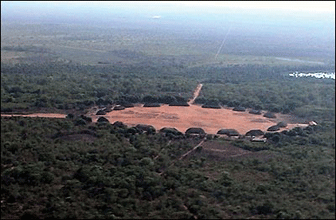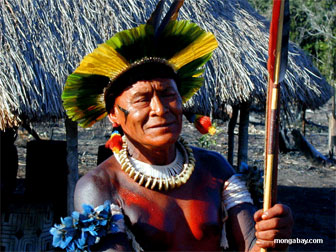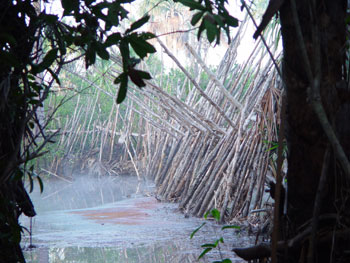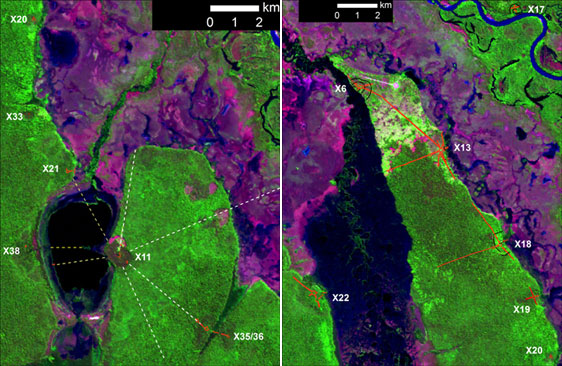Ancient Amazon tribes lived in sustainable “garden cities”, argues new research
Researchers have uncovered new evidence to support the controversial theory that parts of the Amazon were home to dense “urban” settlements prior to the arrival of Europeans in the 15th century. The study is published this Friday in the journal Science.
Conducting archeological excavations and aerial imagery across a number of sites in the Upper Xingu region of the Brazilian Amazon, a team of researchers led by Michael Heckenberger found evidence of a grid-like pattern of 150-acre towns and smaller villages, connected by complex road networks and arranged around large plazas where public rituals would take place. The authors argue that the discoveries indicate parts of the Amazon supported “urban” societies based around agriculture, forest management, and fish farming. Heckenberger and colleagues write that the structure of settlement is similar to that found in other forest regions, rather than the centralized metropolises of Egypt and Mesopotamia.
 A comtemporary Kuikuro village in the Amazon rainforest. Image © Science/AAAS  Kayapó shaman. The Kayapó are a Xinguano tribe that lives in the region. |
The researchers say that while none of the discovered towns were as large as the largest medieval or Greek towns, they had features — including an “identical formal road, always oriented northeast to southwest in keeping with the mid-year summer solstice, connected to a central plaza” — indicative of “regional planning and political organization that are hallmarks of urban society,” according to statement from the University of Florida.
“These are not cities, but this is urbanism, built around towns,” Heckenberger said. “They have quite remarkable planning and self-organization, more so than many classical examples of what people would call urbanism.”
Lessons for current land use in the Amazon
The authors suggest that ancient Amazonian societies may provide insight for modern day efforts to sustainably use the region, which is fast being cleared for industrial soy farms and cattle ranches. For example, instead of extensive monocultures which are sensitive to inclement conditions and are at constant risk from pests, a wiser land use might be modeled on the “garden cities” of indigenous Amazonians, where a resilient mix of agroforestry and aquaculture maintain and even enhance biological diversity, while providing nourishment to local populations.
 A modern Kuikuro dam, used to help funnel fish (the Kuikuro’s primary source of protein) into submerged fish weirs. Afukaka Kuikuro, one of the authors of the paper, is a member of the Kuikuro, the indigenous Amazonian people who are the descendants of the subject settlements’ original inhabitants. Image © Science/AAAS |
“Our findings emphasize that understanding long-term change in human-natural systems has critical implications for questions of biodiversity, ecological resilience, and sustainability,” the authors write. “Local semi-intensive land use provides ‘homegrown’ strategies of resource management that merit consideration in current models and applications of imported technologies, including restoration of tropical forest areas. This is particularly important in indigenous areas, which constitute over 20% of the Brazilian Amazon and ‘are currently the most important barrier to deforestation.'”
“The recognition of complex social formations, such as those of the Upper Xingu, emphasizes the need to recognize the histories, cultural rights, and concerns of indigenous peoples—the original architects and contemporary stewards of these anthropogenic landscapes—in discussions of Amazonian futures.”
Heckenberger and his colleagues first announced the discovery of the settlements in a paper published in Science in 2003. The research contributed to a lively debate over the pre-Colombian human population density in the Amazon. While most experts believe most settlement of Amazonia was limited to the river banks of major rivers and that the bulk of region was sparely populated, some have argued that the rainforest may have supported far higher populations than previously imagined.
Regardless of the controversy, it is increasingly clear that at least some parts of the Amazon supported sizeable and sedentary societies of great complexity. These societies produced pottery, cleared sections of rainforest for agriculture, and managed forests to optimize the distribution of useful species.
 [left] Southern (Kuhikugu) cluster (hatched lines are projected from mapped village earthworks); [right] Northern (Ipaste) cluster sites. Global Positioning System (GPS)-mapped earthworks are denoted by red lines for road and plaza berms and black lines for ditches in (B) and (C). Pronounced anthropogenic “scarring” is found around areas of prehistoric sites. Images © Science/AAAS |
Archeological records suggest the “urban” centers of Amazonia peaked between 1250 and 1650 A.D. Their undoing was the arrival of Europeans, who introduced diseases that may have killed 90 percent of the indigenous population upon first contact. In later centuries, warfare and enslavement at the hands of European settlers further diminished native populations. Their towns, villages, road networks, and elaborate plazas were reclaimed by the forest, leaving little trace of their existence.
Michael J. Heckenberger et al (2008). Pre-Columbian Urbanism, Anthropogenic Landscapes, and the Future of the Amazon. SCIENCE 29 AUGUST 2008 VOL 321
Related articles
Heavily-populated Amazon was decimated by old world disease
(6/9/2008) Ecologists and archaeologists agree that when Columbus struck the Americas in 1492 everything changed, but questions persist over the kind of world Columbus and his followers would soon transform. Recently the state of the pre-Columbian Amazon has been under increasing debate among scientists across numerous fields. In a lecture given at the ATBC conference (Association of Tropical Biology and conservation) in Paramaribo, Suriname, Dr. Francis Mayle weighed in on the debate.
Ancient Amazonian technology could save the world
(5/17/2007) Terra preta, the ancient charcoal-based soil used by ancient Amazonians to create permanently fertile agricultural lands in the rainforest, is getting serious consideration as a means to fight global warming and meet domestic energy demand, reports an article in Scientific American.
Amazon Stonehenge suggests advanced ancient rainforest culture
(5/14/2006) The discovery of an ancient astrological observatory in Brazil lends support to the theory that the Amazon rainforest was once home to advanced cultures and large sedentary populations of people. Besides the well-known empires of the Inca and their predecessors, millions of people once lived in the forests and shaped the environment to suit their own needs. Archaeologists with the Amapa Institute of Scientific and Technological Research said they uncovered the ruin near Calcoene, 390 kilometers (240 miles) from Macapa, the capital of Amapa state, near Brazil’s border with French Guiana.